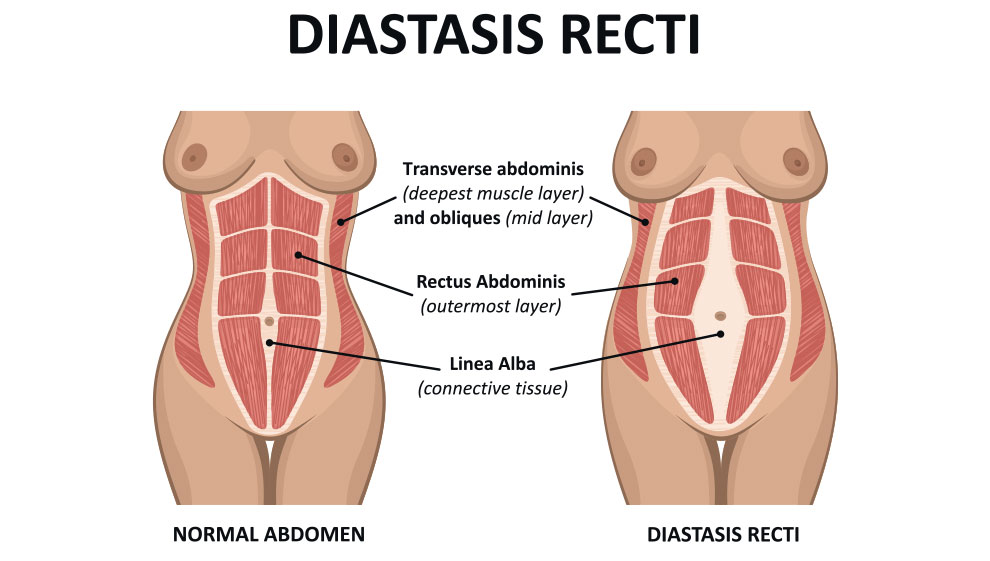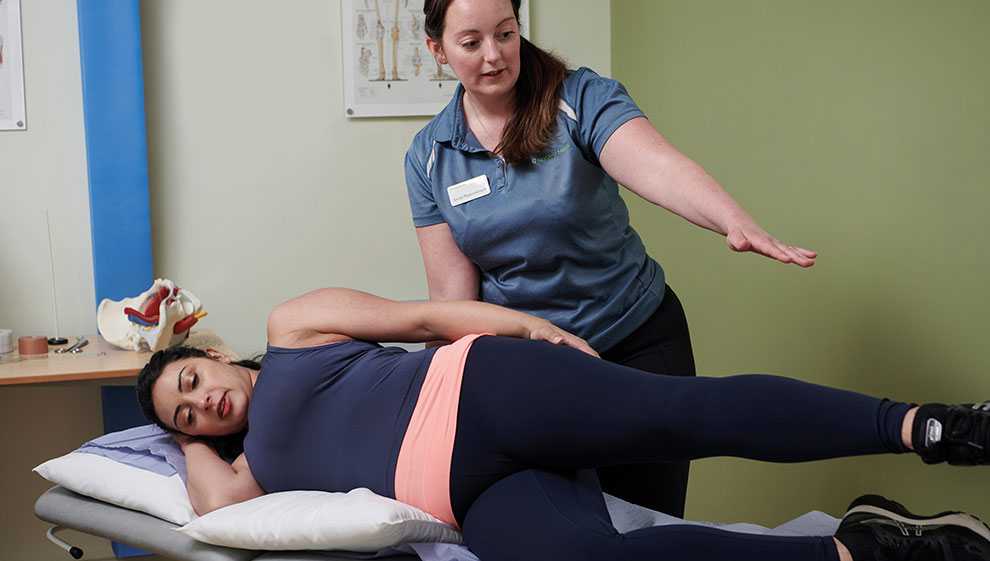Diastasis Recti – Bridging The Gap
What is a diastasis recti?

A diastasis recti refers to a widening and softening of the line of connective tissue that runs down the centre of your tummy, the linea-alba, and separates the rectus abdominus muscle, which is commonly known as the “6 pack muscle”. This can often be felt as a gap in the tummy muscles and can affect the function of the abdominal wall.
It's quite normal to develop a diastasis recti during pregnancy as this is one of the many clever ways your body adapts to the changes your body goes through.
How do you know if you have a diastasis recti?
If you have a diastasis recti you may see doming or tenting of the abdominal muscles when you try and do any activities that increase pressure in the abdomen, such as coughing, sneezing, lifting and some core exercises. It can also contribute to lower back pain and increase your chances of developing pelvic floor symptoms such as stress incontinence and pelvic organ prolapse.
Don’t get too fixated on the size of the gap as this isn't important – the depth of the gap and whether you are able to tense along the linea-alba is what you should focus on. If you can tense along the midline then the abdominal wall is functional, and it is able to transfer load. If you struggle to tense then you should speak to a women's health physiotherapist who will be able to assess your diastasis recti in different positions and loads, and offer advice on how to reduce the gap.
Risks of developing a diastasis recti
There's still a lot we don’t know about why some people develop a significant diastasis recti and others don’t, but the following factors may increase your risk of developing one:
- Having a large baby
- Having multiple children – the risk can increase with each child that you have
- The quality of your connective tissue. Stretch marks can be an indicator of how good your skin is at stretching – the more stretch marks you have, the more likely you are to develop a diastasis recti
- Having a lot of uterine fluid
- Being overweight
- Having a narrow pelvis.
Tips to fix a diastasis recti
Breathe
Avoid holding your breath to perform simple activities such as turning in bed or getting up out of a chair, or even picking up baby. Breath-holding can cause an increase in intra-abdominal pressure and can put excessive force on your diastasis recti. Instead, gently engage your lower abdominals and pelvic floor and breathe out as you get up or pick up baby.
Preparing to move can make a big difference in how you feel. You may also find it easier to log roll in and out of bed, breaking the movement of getting up into little stages:
- First roll onto your side
- Lower your legs
- Sit up and then finally stand, making sure you maintain steady breathing as you do so.
Look after your bowels and avoid constipation
Having a regular bowel motion that requires no straining to empty can make a difference on the pressure generated in your abdomen. You can also try placing your feet on a small stool, so that your feet are wide apart, and your knees sit higher than your hips. This will improve your anorectal angle and make it easier for you to push the bowel motion out.
Instead of holding your breath as you bear down to empty your bowels, try a “moo” or “grr” sound and see which gives you a more open feeling in your bowels. This helps keep the glottis open and prevents the development of pressure within the abdomen.
Paying attention to what you are eating can also make a difference. Ensure you are eating a diet rich in fibre and fruit and vegetables and that you maintain adequate hydration. This will help with the formation of a good stool that is easy to pass.
Sleep well
Asking a mum of a newborn to sleep more may seem like an impossible task, but sleep is key for recovery from both physical and psychological stress. Sleep deprivation can lead to increased injury risk and lower general health.
Current research recommends 7–9 hours of sleep, but how many mums do you know that are actually managing this? You could try using daytime naps to help extend the sleep period and you could also look at improving your sleep quality by improving your sleep hygiene.
Avoid strained lifting
Repetitive strained lifting can lead to increased intra-abdominal pressure and can put undue stress on the diastasis recti. Everyone's different and the level at which you might feel strain varies from person to person.
It's important that you get to know your post-natal body and learn to listen and respect it. The knack is to engage your pelvic floor and lower abdominals. Supporting your tummy with a pillow or folded towel can really help when you perform high pressure activities such as a cough or a sneeze.
Should I wear a support belt?
Historically, binders have been recommended for the management of diastasis recti. This is based on the theory that offloading the linea-alba will help it heal. However, this does not fit in with current theories on collagen repair. More recent research suggests that in order to improve tissue quality we need to gradually load the linea-alba so that it can become stronger and better perform its job of transferring load from the trunk to the pelvis and help provide stability. This has seen a shift away from using supports such as binders.
In the first few weeks after having a baby, if you have a significant diastasis recti you may find it more comfortable to wear a light support that gives a little compression, such as size K–L tubi-grip, which can be ordered from your chemist. There are also some post-partum supports available on the market which help the abdominal muscles perform their job better by providing a little compression – your physiotherapist can help you decide if this is a good option for you.
What exercises to avoid with diastasis recti
It's important to be careful of exercises that increase intra-abdominal pressure and the exercises you can do depends on where you are in your recovery journey. High risk exercises may include sit-ups, V-sits and double leg raises, but equally you may struggle with more simple exercises.
It's also important that you watch your form and technique when performing any exercise. Make sure you aren't holding your breath and that your tummy is not excessively doming or tenting.
Other signs that an exercise might not be the right one for you include pain or pelvic floor symptoms, such as incontinence or heaviness in the vagina, which can be a sign of prolapse. That doesn’t mean that these types of exercises will be off limits forever and research shows that we need to progressively load the linea-alba to see improvement in tissue quality so that it can get better at performing its job of transferring load through the abdomen. Your physiotherapist can help put together a rehab program that's right for you.
We also have a number of post-partum exercise videos to help with your recovery on Nuffield Health 24/7.
How can physiotherapy help with a diastasis recti?

If you think you have a diastasis recti after giving birth, it is important that you book in to have an assessment with a specialist women’s health physiotherapist. Especially if you want to return to running or other high-level sports, or are suffering with pain or pelvic health symptoms such as incontinence or prolapse.
Your physiotherapist will perform an in-depth assessment specific to you and your needs and start you on a holistic and bespoke rehab program aimed at getting you back to doing the things you love.
There's not a “one size fits all approach”. Your physiotherapist can help find the right exercises and management strategies for you and progress them safely when you are ready.
Be kind to yourself!
This is probably the most important action you can take. Your body has been through a lot of changes during pregnancy and having a baby is hard work.
It's important that you give yourself enough time to heal and recover and not have unrealistic expectations of how your body should look, or how quickly it should return to normal after having a baby.
Remember, it took your body 9 months to change and grow with your baby. Your body's amazing but needs time and patience to heal and recover, and collagen can take up to 2 years to improve.
Last updated Friday 24 September 2021
First published on Monday 13 September 2021

